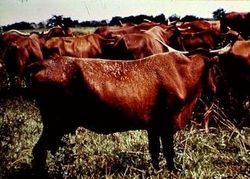Dermatophilosis
| This article is still under construction. |
| Also known as: | Cutaneous streptothrichosis Lumpy wool Strawberry foot rot |
Description
A group of diseases affecting the epidermis caused by dermatophilus congolensis . Causes a range of conditions in large animals including rain scald in horses and strawberry foot rot in sheep. Associated with skin trauma, prolonged wetting or parasites. Lesions typically involve exudative dermatitis with scab formation. A zoonosis affecting humans in close contact with infected animals.
Signalment
Can be seen in animals of all ages but most commonly occurs in young animals who are chronically exposed to moisture. Affects horses, sheep, cattle, goats, pigs and rarely dogs and cats.
Diagnosis
Can often make a diagnosis on history and physical exam. Impression smears can also be useful when stained with either gram stain or Giemsa and examined microscopically. Additionally it is possible to culture material from the crusts however this can be difficult due to the slow- growing nature of the pathogen.
History and Clinical signs
Lesions commonly occur followng heavy rainfall and commonly affects the dorsum of animals. Any previous trauma or damage to the skin can predispose to infection. Blood-sucking insects are also thought to be involved in transmission.
Equine dermatophilosis
Three clinical syndromes have been documented:
- rain scald
- Mud fever
- Grease heel.
Typically hair becomes matted and focal lesions develop into crusts and thick scabs covered by layers of yellow-green pus. When scabs are removed the hair is taken with them and alopecia results. Rain scald commonly affects the dorsum, shoulders and neck. It can however extend to lower portions of the body and abdomen. It typically begins as small rough raised bumps and can go un-noticed in0 long haired regions. Mud fever looks similar to rain scald but affects the pasterns and distal limbs. White legs and white- skinned areas are most commonly affected. Grease heel is a disease complex which presens in the same way as rain scald and mud fever over the heels. It produces a grey exudate which feels greasy to touch. The disease complex can involve dematophilosis as well as a number of other conditions including dermatophytosis, pastern folliculitis, pyoderma, photosensitisation, contact dermatitis and chorioptic mange.
Ovine dermatophilosis
Three clinical syndromes have been documented:
- Lumpy wool
- Strawberry foot rot
- Fleece rot
Fleece infection is known as lumpy wool. Infection passes from ewe to lamb during suckling and hence lesions first appear on the head which leads to infection on the trunk. In wet weather can result in high morbidity outbreaks. Large areas of the fleece can be affected where crusts of varying thickness become evident. On haired skin, crusts can become very thick and can form horn like structures. In rams, severe infections can result in the scotum and surrounding skin becoming affected.
Strawberry foot rot is a condition affecting the skin from the coronet to the carpus or hock. The disease occurs as a result of Orf and Dermatophilus infection. Scabs get rubbed away leaving the granulating surface qhich resembles a strawberry.
Fleece rot A condition thought to be assosiated with dermatophilosis, but also involves pigment producing bacteria which stains the wool a characteristic yellow colour. Predisposes to fly strike.
Bovine dermatophilosis
Is rarely reported but causes lesions are distributed over the head, dorsum, neck and chest. Cattle that stand for long periods in deep water and mud develop lesions over the flexor surfaces of the joints. Dairy cows may develop lesions on the udder.
Lesions may resolve within weeks if dry weather or prolonged wetting of infected areas can lead to secondary bacterial infection which can result in limb oedema and cellulitis.
Pathology
Grossly: Papules, pustules, crusts may coalesce and mat the coat
Microscopically:
- Hyperplastic superficial perivascular dermatitis
- Multilaminated crusts, alternating keratin and inflammatory cell layers
Treatment
Horses: Bring affected animals into a dry environment and isolate. Scabs should be soaked and removed. Chlorhexidine and benzoyl peroxide are recommended as topical antibacterials. Tack and any other equipment should be disinfected to avoid further infection. Systemic antibiotics should be administered if secondary infection is present. Owners should be educated about the condition and warned that reoccurence may occur in wet weather.
Farm animals: Bring affected animals into a dry environment. Investigate any underlying problems which may predispose to the infection. Antibiotics can be given intramuscularly and typically work following one dose. However is signs do not resolve a 5 day course should be administered. Penicillin and streptomycin are good choices for this disease. Additionally Dips containing 0.2% Copper Sulphate or 0.5% Zinc sulphate can be affective.
Prognosis
Good if animals or kept dry. Often re-occurs in wet weather.
References
Merck & Co (2008) The Merck Veterinary Manual (Eighth Edition) Merial 4th year Veterinary Dermatology notes. Royal Veterinary college. October-November 2008. p60-64.
